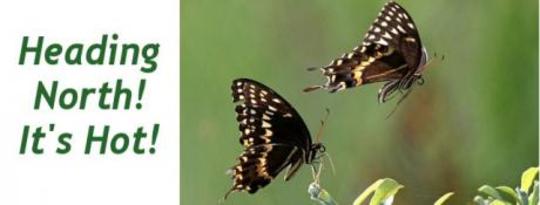
One of the ways we can tell how climate is changing is how other living things adapt. Whether it is the sugar maple tree or the swallowtail butterfly, even the most casual observer detects the differences. These changes, as well higher or lower temperatures, occur as you move north and south and as elevation changes.
Climate change: Species climbing higher and migrating north, study says
CHRISTIAN SCIENCE MONITOR - by Pete Spotts. August 19, 2011.
Organisms are responding to climate change at a pace much faster than scientists estimated about a decade ago, according to a new study in the journal Science.
Researchers in Britain analyzed dozens of studies tracking changes in the ranges of some 1,376 species of plants, animals, and insects. They found that a warming climate is driving species toward higher latitudes at an average of nearly twice the pace that studies indicated in 2003. And species are migrating to higher altitudes nearly three times faster.
Continue Reading the Article...
Butterflies Booking It North as Climate Warms
MOTHER JONES - by Julia Whitty. Thu Jan. 31, 2013.
 Butterflies from the southern US that used to be rare in the northeast are now appearing there on a regular basis. The trend correlates to a warming climate report the authors of a paper in Nature Climate Change.
Butterflies from the southern US that used to be rare in the northeast are now appearing there on a regular basis. The trend correlates to a warming climate report the authors of a paper in Nature Climate Change.
Subtropical and warm-climate butterflies—including the giant swallowtail (photo above) and the zabulon skipper showed the sharpest population shift to the north. As recently as the late 1980s these species were rare or absent in Massachusetts.
Continue Reading the Article...
Trees Migrating North Due to Warming
NATIONAL GEOGRAPHIC NEWS - Bruce Dorminey. February 9, 2009.
Other than the Ents of Lord of the Rings fame, trees generally aren't known for their mobility. So news that some tree species may be headed north at an average clip of 62 miles (100 kilometers) a century may come as a surprise.
That's the finding of a new study led by the U.S. Forest Service, which concludes that a few dozen tree species in the eastern U.S. are moving north at an unexpected rate, likely due to global warming.
In a paper appearing this month in the journal Forest Ecology and Management, the study authors documented the northward march of 40 major tree species over 30 eastern states based on the distribution of seedlings versus mature trees.
Continue Reading the Article...
More:
Google Scholar Search - Species move north with global warming.

Related Books:
The Future We Choose: Surviving the Climate Crisis
by Christiana Figueres and Tom Rivett-Carnac
The authors, who played key roles in the Paris Agreement on climate change, offer insights and strategies for addressing the climate crisis, including individual and collective action.
Click for more info or to order
The Uninhabitable Earth: Life After Warming
by David Wallace-Wells
This book explores the potential consequences of unchecked climate change, including mass extinction, food and water scarcity, and political instability.
Click for more info or to order
The Ministry for the Future: A Novel
by Kim Stanley Robinson
This novel imagines a near-future world grappling with the impacts of climate change and offers a vision for how society might transform to address the crisis.
Click for more info or to order
Under a White Sky: The Nature of the Future
by Elizabeth Kolbert
The author explores the human impact on the natural world, including climate change, and the potential for technological solutions to address environmental challenges.
Click for more info or to order
Drawdown: The Most Comprehensive Plan Ever Proposed to Reverse Global Warming
edited by Paul Hawken
This book presents a comprehensive plan for addressing climate change, including solutions from a range of sectors such as energy, agriculture, and transportation.


























